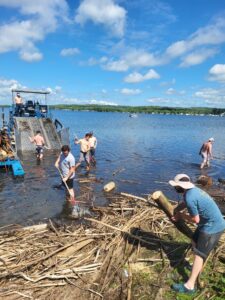CLA Begins Clean-Up Of Burtis Bay
- Working crews with the Chautauqua Lake Association Thursday began cleaning up a debris field of Japanese Knotweed which floated into the Bertus Bay area more than two-weeks ago. Submitted photo
- Working crews with the Chautauqua Lake Association began clean-up operations in the Bertus Bay area of Celoron Harbor Thursday morning. Submitted photo

Working crews with the Chautauqua Lake Association Thursday began cleaning up a debris field of Japanese Knotweed which floated into the Bertus Bay area more than two-weeks ago. Submitted photo
CELORON – Clean-up efforts are underway at Bertus Bay to remove a rather large Japanese Knotweed debris field that made its home in the bay area more than two weeks ago
The Chautauqua Lake Association (CLA) is leading the effort to remove the debris from the lake. This follows what the CLA’s Executive Director, Douglas Conroe, said would happen in a May 10 article in the Post-Journal.
The CLA crews dedicated their Thursday morning to the removal of invasive plants. As the debris field was moved down the lake more than two weeks ago, to its final resting place, a fisherman remarked that it resembled “an aircraft carrier in the lake,” extending over three football fields in length and spanning more than 50 feet in width.
Jane Conroe, director of the Chautauqua-Conewango Consortium, told The Post-Journal, “That the streamside knotweed was likely caused by improper disposal years ago. She said it’s not uncommon for the plant to look dead yet still alive and spreading. Japanese Knotweed is extremely invasive and aggressive.”
Doug Conroe discussed the lake’s water flow dynamics, noting that Celoron acts as a ‘catcher’s mitt’ for the entire lake system. As a result, debris fields and other navigational hazards often accumulate in the Bay Area.

Working crews with the Chautauqua Lake Association began clean-up operations in the Bertus Bay area of Celoron Harbor Thursday morning. Submitted photo
According to the United States National Park Service, Japanese Knotweed stalks have been compared to those of bamboo, hollow and segmented. However, the plant is in the buckwheat (Polygonaceae) family. The leaves are broad, complete, and alternating. The stems tend to take on an orange color once they mature, while the leaves are dark green. Each stalk of flowers at the end of the summer growing season produces clumps of small, white flowers. After fruit is made, the stalks are killed off by the fall season’s first frost.
However, they quickly return from rhizomes below them come spring. Additionally, Japanese knotweed grows in dense stands and quickly reaches incredible heights. This makes it almost impossible for herbivores to feed on or trample it to keep it under control. Its roots are also incredibly hardy, and the only way to permanently remove a stand of Japanese knotweed is to completely dig out and remove its rhizomes, a nearly impossible feat.





